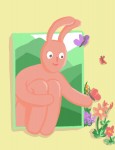Art, the universal language, can transcend space and time to reach a diverse audience. We hear this all the time, but do we truly feel the weight of these words? A cloud of elitism envelops the “art world,” alienating the perspectives of some while glorifying those of others. In efforts to challenge ideas that reinforce the intrinsic validity of one individual’s take on art over another’s, columnist Lisa Aubry will explore different creative spaces and outlooks on art and reconcile the fields of arts and sciences through discussions.
Imagine embarking on a hike through the Italian Alps. Panting, you finally reach the peak, where you are suddenly greeted by a gargantuan pink stuffed rabbit.
This is not a drill. This is “Hase,” an outdoor sculpture by Austrian artist collective Gelitin. The artwork is one of many that author Linda Weintraub discusses in her literary works on environmentally conscious art. Through conversations with UCLA Art|Sci Center guests and members, I explored the potential and current applications of unifying art with ecology.
Weintraub wrote the first ever textbook on eco art, “To Life!: Eco Art in Pursuit of a Sustainable Planet,” which is now part of the curricula at various art schools. She said the genre of eco art is revolutionary because it aims to reverse conventional social and ethical values. At the same time, it introduces alternative behaviors to bring about remediation or preservation. By writing about eco art, Weintraub said she hopes to make the concept more accessible, spreading awareness about the planet’s current state and inspiring an effective, active response from viewers.
“It is my opinion that there is no more urgent or critical area of exploration than the state of our planet at the moment,” she said. “My mission is to enlist more and more creative people into caring for the planet one way or another, and I think artists are particularly equipped to (fulfill) that role.”
[RELATED: Students delve into campus trash to shape sculptures about sustainability]
Increasing visibility and acceptance of eco art has not always been smooth sailing, Weintraub said. A rigid sense of what does and does not count as true artwork continues to float around in some parts of the creative community. Certain fine art professionals tend to reject eco art because it deviates from traditional practice and presents a threat to their own relevance because of the urgent issue it tackles, Weintraub said.
“I have found often that the people who are the most unforgiving and unwilling to accept alterations are those who are really invested in art … and then they encounter something which is called art and is so alien from what they are doing,” she said. “The easiest thing to do is reject those experiments as not really being art.”
But who could refuse a big pink bunny? In her textbook, Weintraub discusses “Hase,” which Gelitin created to demonstrate that the decomposition process is beautiful and essential to sustaining the vibrancy of life. They stuffed the 200-foot-long knitted rabbit with biodegradable materials, such as locally grown straw, that should decompose over the course of 20 years, fertilizing the mountaintop in Piedmont, Italy.
Artistic efforts by Olivia Osborne, an environment and human health scientist, share similar goals of spreading knowledge about environmental phenomena like climate change. One of Osborne’s multidisciplinary projects, “Meltings of the heart change glacial landscapes,” pertains directly to ecology. To create this time lapse of multicolor melting ice, she said she sprinkled water-repellent dyes and salt onto “ice domes.”
Salt works to lower the melting temperature of ice, accelerating its melting rate. In the same way external factors like chemicals affect ice, external situations and people can “melt” the human heart. The piece draws parallels betweeen the vulnerability of the human heart and the fragility of the environment in the face of climate change, Osborne said.
Instead of reaching out to people through infographics and scientific jargon, Osborne said she prefers to capture attention and garner emotional responses towards climate change through art. “Meltings of the heart change glacial landscapes” also served as an interactive exhibit in which people could touch the colored ice and forge an immediate visceral response to it. Because of the human body’s naturally warm body temperature, the ice melted upon touch, representing the reality of societal impact on climate change.
“People ask me whether 1 degree (Celsius) is going to make a difference and the answer is yes, massively,” Osborne said. “But of course on a graph you wouldn’t even notice a 1 degree difference, whereas (the project) showed how this ice melts and you cannot put it back together.”
[RELATED: Art to Heart: Intersection of art and math generates visually complex representations of nature]
Osborne also created a series called “Cry me a River, California.” She said the state’s period of drought inspired the watercolor landscapes that feature California palm trees. Osborne said she used canvas, which tends to absorb watercolor, as opposed to a more conducive paper material. Her ability to trap the water on the canvas’ surface with a glass resin coating exposes the possibility of trapping water in California by improving humans’ treatment of water resources and curtailing wasteful habits, Osborne said.
Playing with materials to create metaphorical meaning about the environment proved more effective for reaching a broader audience, Osborne said. She remarked on how complex graphs tend to discourage the typical viewer from gaining knowledge about significant scientific findings – ignorance about the urgency of climate change is a luxury we cannot afford.
“You need to explain it without degrading the science, but you have to give people the opportunity to understand it,” Osborne said. “Knowledge is power.”
Writers like Weintraub, artists like those in Gelitin and scientists like Osborne explore ecology through captivating artistic media. The possibilities seem endless, and this is certainly good news, given the issues they tackle. Taken together, the fields of art and ecology are a force to be reckoned with – one that might just be life-saving.
